No CrossRef data available.
Article contents
Nuria Lorenzo-Dus, Digital grooming: Discourses of manipulation and cyber-crime. Oxford: Oxford University Press, 2022. Pp. 240. Hb. £64.
Review products
Nuria Lorenzo-Dus, Digital grooming: Discourses of manipulation and cyber-crime. Oxford: Oxford University Press, 2022. Pp. 240. Hb. £64.
Published online by Cambridge University Press: 01 February 2024
Abstract
An abstract is not available for this content so a preview has been provided. Please use the Get access link above for information on how to access this content.

- Type
- Book Notes
- Information
- Copyright
- Copyright © The Author(s), 2024. Published by Cambridge University Press



